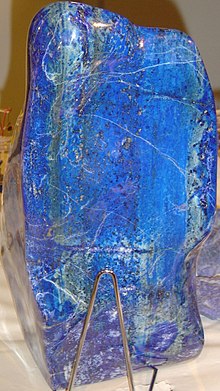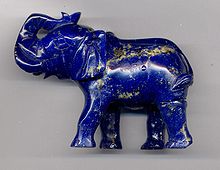Lapis lazuli
Lapis lazuli , also called lapis lazuli ( lapis lazuli ), lazur stone or lapis for short , is a naturally occurring, deep blue metamorphic rock that, depending on where it was found, consists of different proportions of the minerals lazurite , pyrite , calcite and minor admixtures of diopside , sodalite and others.
etymology
The word lapis comes from the Latin language and means "stone". Lazuli , genitive of the Middle Latin word lazulum for “blue”, is derived from the Persian language like Middle Latin lazurium and Greek lazoúrion via Pashtun لازورد lāzawardلاجورد/ lāǧevard / 'sky blue'. Synonyms include Azur d'Acre, azurum ultramarinum, Bleu d'Azur, Lapis lazuli ultramarine , Las (z) urstein, Lazurium, Oltremare, Oriental blue, Outremer lapis, Pierre d'azur, Ultramarine real, Ultramar ino / verdadero, Ultramarine natural; furthermore after Pliny and Theophrast coeruleum scythium .
Chemistry and color

The first characterizations of this mineral colored pigment were made by Andreas Sigismund Marggraf in 1768. The first chemical analysis of the main component of lapis lazuli, the glaze stone , was carried out in 1806 by the French chemist Nicolas Clément with an accuracy that is already good from today's perspective ( Silice : 35.8%, Alumine : 34.8%, Soude : 23.2%, Soufre : 3.1%, Chaux carbonatee : 3.1%). On this basis, ways of producing artificial ultramarine , which should correspond as closely as possible to natural lazurite, were sought and developed almost simultaneously in the 1820s by the French chemist Jean-Baptiste Guimet and the German chemist Christian Gottlob Gmelin . Investigations of natural and artificial ultramarine as well as the related minerals sodalite , nosean and hauyn with physical methods (from 1929 with the X-ray structure analysis ) led to the realization that these substances belong to the group of aluminosilicates .
Popular gemstones are of an intense, ultramarine blue color, which can be traced back to • S 3 - radical anions of sulfur in the idealized formula Na 6 [Al 6 Si 6 O 24 ] S x Ca (with x> 1). Finely divided pyrite serves as proof of authenticity. Spots or small gold-colored pyrite veins are also appreciated, but the proportion of pyrite should not be too large, otherwise the color will turn into an unsightly green. Stones in which the calcite is prominent are less valuable.
The various deposits produce nuances of color. Tajik lapis lazuli tend to be navy blue, while those found at Lake Baikal have blue-violet tones and particularly strong calcite components.
Education and Locations
Lapis lazuli is mainly produced through contact, metamorphic or metasomatic processes in amphibolites , gneiss , marble , peridotites and pyroxenites, among others . In addition to the rocks mentioned, the minerals afghanite , apatite , dolomite , hauyn , nepheline , sulfur , tremolite and others can also be associated.
The most famous sites are in the western Hindu Kush , in the Badachschan province in Afghanistan. In the Afghan civil war for control of the played Panjshir -Tals, in addition to its strategic importance as a supplier of expensive Lapislazulis an important role as a source of revenue to purchase weapons. The mines at Sar-é Sang in the Koktscha Valley were already in operation in ancient Egypt . The rock was blasted with wood fires: Sudden quenching with cold water caused cracks so that it could then be knocked out. Today in Badachschan they work with explosives.
Other important sites are in Russia. Here the best-colored varieties come from the Malobystrinskoye deposit on Lake Baikal . The Talskoye and Sljudjanskoye locations in the Baikal region proved to be less productive . Erich G. Laxmann discovered the site on the Slyudyanka River in the years 1784–1785 when he was conducting scientific research on Lake Baikal on behalf of the Tsar's Academy of Sciences . Catherine the Great sent a geological expedition to this region in 1787 to obtain more detailed information on usable gemstones and minerals. As a result, samples of lazurite were also sent to St. Petersburg.
Other sites are in Tajikistan near Lyadschwar-Dara in the Pamir ( Berg-Badachschan / Schachdarakette ). There are also localities at Ovalle in Chile, in Iran as well as in the Cascade Canyon of California and at Magnet Cove in Arkansas (USA).
Prehistoric evidence
The oldest evidence of lapis lazuli gemstones comes from the South Asian Mehrgarh culture . For phase II of this culture (around 5000 BC), the mineralogical origin from the northern Afghan province of Badachschan is documented. The mining near Sar-e-Sang is demonstrated 6000 years ago. The Ladjuar Medam ( Lajur Madan ) deposit there is also the mineralogical type locality for lazurite. The mining tunnels in the mountain slopes of kokcha river -Tals are at 1500 to 5000 meters. The lapis lazuli obtained here came to distant regions of Asia as a commodity in the form of unprocessed blocks and polished beads. Structural analyzes showed that, for example, the material available at the archaeological site of Schahr-e Suchte (around 2700 to 2300 BC) in eastern Iran comes from the Koktscha Valley. The residents of Tepe Hissar in Northern Iran also imported lapis rock. In both places, workshops from the middle of the 3rd millennium were excavated in which, in addition to pieces of lapis lazuli, tools for processing were found: drills and blades made of flint , as well as pestles and smoothers made of jasper .
Lapis lazuli already had an immaterial, symbolically charged meaning in ancient times. In ancient Egypt , the import of lapis gemstones has been documented since the 1st dynasty during the reign of Djer (around 2980 BC). The absence of the rock in the 2nd and 3rd dynasties is explained with hindrances to the trade routes. Lapis lazuli appears regularly in the graves of the pharaohs of the New Kingdom . In Tutankhamun's golden death mask , the eyes are rimmed with lapis lazuli inlays, and the eyebrows each consist of several lapis plates. In the wide collar over the chest and in the ring on the left hand there are set lapis stones. On other parts of the Tutankhamun mask, lapis blue colored glass applications were used, for example on the much larger stripes in the Nemes headscarf . Scarabs made from lapis lazuli stone were also popular with the Egyptians .
Representatives of the Indus culture settled in around 2200 BC. BC in the northern Afghan city of Shortugai to exploit the local lapis lazuli deposits and trade them in the form of pearls.
The lapis lazuli found in Mesopotamia also came from northern Afghanistan. Jewelery from the royal tombs at the ziggurat of the moon god Nanna in Ur , exhibited in the Vorderasiatisches Museum Berlin and in London, shows the abundant use by the Sumerians (approx. 2000 BC).
The Assyrian King Šamši-Adad I (18th century BC) mentioned lapis lazuli among the precious materials from other countries. It is said that in Aššur , the capital of Assyria , it cost half the price of silver. As a gem, it got further west. Lapis lazuli was also obtained from Aššur in the Hittite town of Kaniš , where it was three times the price of silver. In Ugarit on the Mediterranean coast there are tombs where lapis lazuli pearls were sewn onto precious garments. In the Epic of Gilgamesh approximately contemporaneous tradition lapis lazuli is mentioned several times.
In the Central and Northern European Late Bronze Age , blue-colored glass beads are also occasionally documented as grave goods . As could be proven by means of plasma mass spectrometry , these imports come from Egypt and Mesopotamia, but these are usually colorations with cobalt . In 2017 a glass bead was first known, which was apparently colored with lapis lazuli.
Use in the Middle Ages and modern times
Gemstone
Lapis lazuli has been used as a gemstone since prehistoric times at least 7000 years ago (see section above ). With real glaze stone, golden glittering pyrite particles can often be seen.
Exposed examples of the use of lapis lazuli gem stone continue into modern times . The canonized Aloisius von Gonzaga († 1591) was buried in an urn made of lapis lazuli. In the church Il Gesù in Rome (around 1700) the altar of the St. Ignatius Chapel was decorated with lapis lazuli columns and a lapis blue globe set in gold. For a long time the globe was considered to be the largest work of art made from a lapis block. However, recent research shows that it is a mortar with a high proportion of lapis lazuli. The central columns of the iconostasis in St. Petersburg 's Isaac Cathedral (around 1800) are also made of this stone. In the Potsdam Orangery Palace (built from 1851 to 1864), Friedrich Wilhelm IV had a lapis lazuli room built, the furniture of which is decorated with gemstones. From a lapis lazuli monolith of 18.3 t raw mass from Chile, the largest ever recovered, the water wave life fountain in Vienna was designed at the end of the 20th century .
pigment
Lapis lazuli played an important role as a pigment for bright blue and lightfast paint in Western art . The mostly economical use in medieval pictures is due to the fact that the pigment was extremely expensive. As can be deduced from the name “ ultramarine ”, it had to be obtained from traders “across the sea”. The price per ounce for high quality, deep blue pigment was roughly the same as that of gold during the Renaissance .
It could have been used as a pigment in addition to indigo in the Scottish Book of Kells (around 800). In the Codex aureus Epternacensis and other works of Ottonian book illumination , the heavenly sphere was given a material aesthetic, while less significant details were painted with azurite . Since the Quattrocento , the early Italian Renaissance, lapis lazuli and gold have been explicitly recorded in contracts between painters and clients, especially as blue in the design of the Marian robe. The technique for extracting the pigment has been handed down from the records of Cennino Cennini (around 1400). The bright blue sky in the pictures of Fra Angelico or Giotto's frescoes in the Cappella degli Scrovegni ( Padua ) was also painted with filtered lapis lazuli as a pigment. Examples of its use as a basic color material can also be found in the Duke of Berry's book of hours , one of the most important works of book illumination from the 15th century. Even Albrecht Dürer used ultramarine for a number of its commissions. In a letter to the person who commissioned the “ Heller Altar ”, he emphasized the high cost of materials, with an ounce of fine ultramarine costing him ten to twelve ducats .
In the Muslim architecture of Central Asia , lapis lazuli pigment was used for bright blue faience tiles, for example at the Bibi Chanum Mosque and the Ulugbek Madrasa in Samarkand or the Mir-i Arab Madrasa in Bukhara . The material came from deposits in the northern Afghan Koktscha Valley and was negotiated via the Silk Road to the west.
On pottery , lapis lazuli is used for the Lādschvardina goods ( Lādschvard = Persian lapis lazuli ) Persia of the 12th-14th Century, as well as on Meissen porcelain of the 18th century. With the discovery of a process for the production of synthetic ultramarine blue in 1828, the natural pigment increasingly lost its economic importance in Europe. With the artificial "Meißner Lasursteinblau", Friedrich August Köttig developed an inexpensive method for the production of deep blue porcelain colors.
Today, the natural lapis lazuli pigment, which is still very expensive due to the complex extraction process, is valued primarily by restorers in Europe. In East Asia (especially Japan , China ) and Arabia, the high esteem of natural ultramarine as a “heavenly” and thus at the same time stately blue is unbroken. The Japanese artist Hiroshi Ōnishi created a series of paintings with lapis lazuli pigments, for example for the Nanzen-ji temple in Kyoto .
Jan Vermeer used lapis lazuli for the color of the cloth in his painting The Girl with the Pearl Earring
Giottos : Joachim's dream
The sheet “Visitation of the Virgin Mary” in the Duke of Berry's book of hours
Manipulations and imitations
- Pale lapis lazuli is oiled or waxed to make it appear darker. Uneven coloring can be standardized with colored oil, but this can easily be detected with acetone .
- Lapis lazuli of poor quality or in small fragments is reconstructed together with synthetic resin into larger stones .
- Imitations of lapis lazuli are mainly made by coloring the quartz variety jasper with Berlin blue . The so-called “German lapis (lazuli)” is made from jasper in Nunkirchen (town of Wadern ), other names are “Swiss Lapis”, “Blue Onyx ” or “Nunkirchener Lapislazuli”. If you treat inferior gemstone imitations in this way in an ultrasonic bath or with ammonia , spots appear on the stone surface that can no longer be removed because the coloring pigment has been detached.
See also
literature
- Hugo Blümner : Sapphir . In: Paulys Realencyclopadie der classischen Antiquity Science (RE). Volume IA, 2, Stuttgart 1920, Col. 2356 f.
- Gerd Weißgerber: Gemstones in the ancient Orient - lapis lazuli, turquoise, agate, carnelian. In: T. Stöllner: Persia's ancient splendor. German Bergbau-Museum, Bochum 2004, ISBN 3-937203-10-9 , pp. 64–76.
- GeoMuseum TU Clausthal
- EE Kuzmina: The Prehistory of the Silk Road. Edited by Victor H. Mair. University of Pennsylvania Press, 2008.
Web links
- Mineral Atlas: Lapis Lazuli (Wiki)
- Leopold Rössler: Lapis Lazuli, Lasurstein. In: Gem etiquette. March 19, 2010, accessed March 19, 2010 .
- Thomas Seilnacht: Lapis lazuli, lazurite. March 1, 2010, accessed March 19, 2010 .
- Thomas Krassmann: Lapis Lazuli - Occurrence, extraction and market potential of a mineral blue pigment. (PDF; 2 MB) March 6, 2010, accessed on March 19, 2010 .
Individual evidence
- ^ GeoMuseum TU Clausthal - Lapis Lazuli
- ↑ Martin Okrusch, Siegfried Matthes: Mineralogie: An introduction to special mineralogy, petrology and deposit science . 7th edition. Springer Verlag, Berlin / Heidelberg / New York 2005, ISBN 3-540-23812-3 , pp. 125 .
- ↑ a b c d Bernhard Brother: Decorated stones . Neue Erde Verlag, 1998, ISBN 3-89060-025-5 .
- ^ Wilhelm Ganzenmüller : Contributions to the history of technology and alchemy. Weinheim an der Bergstrasse 1956, p. 169.
- ^ Etymological dictionary of the German language : Article Azur .
- ↑ R. Phillips: Ueber Ultramarien and the different methods to test the purity of the same. In: Polytechnisches Journal . 12, 1823, pp. 433-439.
- ↑ Histoire de l'Académie Royale des Sciences et des Belles-Lettres de Berlin, 1768, p. 3.
- ↑ Nicolas Clément and Charles Désormes, Annales de Chimie Volume 57, 317 (1806)
- ↑ Fritz Seel , Gisela Schäfer, Hans-Joachim Güttler, Georg Simon: The Secret of Lapis Lazuli . In: Chemistry in Our Time . tape 8 , no. 3 , 1974, p. 65-71 , doi : 10.1002 / ciuz.19740080302 .
- ↑ P. Kolesar, J. Tvrdý: Tsarist treasures. Bode Verlag, Haltern 2006, p. 567.
- ^ Walter Schumann: Precious stones and gemstones . 13th edition. BLV Verlag, 2002, ISBN 3-405-16332-3 , p. 188 .
- ^ Karin N. Sowada: Egypt in the Eastern Mediterranean during the Old Kingdom. Vandenhoeck & Ruprecht, Göttingen 2009.
- ↑ Klaas R. Veenhof: Mesopotamia. The Old Assyrian Period ; Friborg 2008, ISBN 978-3-7278-1623-9 , p. 84.
- ↑ Horst Klengel : Trade and traders in the ancient Orient. Köhler & Amelang, Leipzig 1979, pp. 25 f., 70, 93, 149
- Jump up ↑ Jeanette Varberg, Bernard Gratuze, Flemming Kaul: Between Egypt, Mesopotamia and Scandinavia: Late Bronze Age glass beads found in Denmark. In: Journal of Archaeological Science. 54, 2015, pp. 168-181, doi: 10.1016 / j.jas.2014.11.036
- Jump up ↑ Jeanette Varberg, Bernard Gratuze, Flemming Kaul, Anne Haslund Hansen, Mihai Rotea, Mihai Wittenberger: Mesopotamian glass from Late Bronze Age Egypt, Romania, Germany, and Denmark . In: Journal of Archaeological Science . 74, 2016, ISSN 0305-4403 , pp. 184-194. doi : 10.1016 / j.jas.2016.04.010 .
- ↑ Blue glass bead proves trade relations with Mesopotamia Die Welt, September 25, 2017, accessed September 25, 2017.
- ^ Robert Fuchs, Doris Oltrogge: Color material and painting technique in the Book of Kells. In: Felicity O'Mahony (Ed.): The Book of Kells: Proceedings of a conference at Trinity College, Dublin, September 6-9, 1992. Scolar Press, Brookfield 1994, pp. 133-171, here p. 139
- ^ Ingrid Bennewitz, Andrea Schindler, Karin Hanauska, Peter Hinkelmanns, Bettina Becker: Color in the Middle Ages: Materiality - Mediality - Semantics. Akademie-Verlag, Berlin 2011, ISBN 978-3-05-004640-2 .
- ^ Jill Dunkerton: Giotto to Dürer: Early Renaissance Painting in The National Gallery. Yale University Press, 1991, ISBN 0-300-05082-8 .
- ↑ Dürer's letter to Jakob Heller of November 4, 1508, cited above. after Bennewitz et al. 2011, pp. 127–129.
- ↑ Jonathan Bloom, Sheila Blair (Ed.): Grove Encyclopedia of Islamic Art & Architecture. Oxford University Press, 2009, ISBN 978-0-19-530991-1 .
- ↑ Aaron N. Shugar, Jennifer L. Mass (Eds.): Handheld XRF for Art and Archeology. Leuven, 2012, p. 269.
- ↑ Philippe Colomban, Véronique Milande: On-site Raman analysis of the earliest known and Meissen porcelain stoneware. In: Journal of Raman Spectroscopy. 37, 2006, pp. 606-613, doi: 10.1002 / jrs.1494 .
- ↑ Lapislazuli-Pigment.de production and sales, accessed June 21, 2018.





